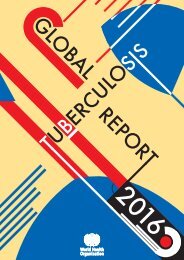patients
DNDi_AR_2015
DNDi_AR_2015
Create successful ePaper yourself
Turn your PDF publications into a flip-book with our unique Google optimized e-Paper software.
LEISHMANIASIS<br />
R&D MODEL & PORTFOLIO<br />
IMPLEMENTATION<br />
New VL treatments - Asia<br />
PROJECT START: July 2010 (Bangladesh)/December 2006 (India)<br />
OVERALL OBJECTIVE: Develop one to two new (combination)<br />
treatments and support recommendations from the authorities<br />
in the main endemic countries. Provide evidence for adoption<br />
of combination treatment as a second line option in national policy<br />
in Bangladesh<br />
2015 OBJECTIVE: Advocate for the adoption of combinations<br />
as second line treatment in Bangladesh<br />
1,761 <strong>patients</strong><br />
recruited at<br />
12 sites in India<br />
The Phase III trial conducted in India<br />
in 2008-2010 demonstrated the<br />
efficacy of combination therapies<br />
based on AmBisome ® , miltefosine,<br />
and paromomycin, and an additional study by Sundar et al.<br />
showed the efficacy of single-dose AmBisome ® given as an<br />
intravenous infusion. To facilitate the introduction of these<br />
new treatments for VL in South Asia, DNDi conducted safety<br />
and effectiveness studies, including a pilot project in the Bihar<br />
State of India (2012-2015) implementing combination therapies<br />
at the primary healthcare level, and single-dose AmBisome ®<br />
at the hospital level.<br />
These regimes were observed to be safe and effective and,<br />
based on the study results, the Indian National Roadmap for<br />
Kala-Azar Elimination in August 2014 recommended use of<br />
single dose AmBisome ® as a first option treatment for the<br />
treatment of VL <strong>patients</strong>, with paromomycin and miltefosine as a<br />
second option at all levels; a policy also reflected in Bangladesh<br />
and Nepal. This removal of miltefosine monotherapy is an<br />
important policy change. The pilot study continued following<br />
up <strong>patients</strong>, documenting 12 month treatment outcomes, at<br />
the request of the national programme; this follow up was<br />
completed in September 2015. Site close out activities will be<br />
completed in January 2016.<br />
In Bangladesh, a two-step Phase III study conducted from 2010-<br />
2014 in 602 <strong>patients</strong> (first in hospital settings, then in primary<br />
healthcare centres) used the same combination therapies<br />
as those tested in India. All tested treatments demonstrated<br />
excellent cure rates and were well tolerated by <strong>patients</strong>, in<br />
support of policy change in the country.<br />
MAIN PARTNERS: INDIA: Indian Council of Medical Research (ICMR);<br />
Rajendra Memorial Research Institute of Medical Sciences (RMRIMS);<br />
Bihar State Health Society; National Vector Borne Disease Control<br />
Programme (NVBDCP); Kala Azar Medical Research Centre; GVK<br />
Biosciences; BANGLADESH: Ministry of Health and Family Welfare;<br />
International Centre for Diarrhoeal Disease Research (ICDDR,B);<br />
Shaheed Suhrawardy Medical College and Hospital; OTHER: Médecins<br />
Sans Frontières (MSF), Spain; London School of Hygiene and Tropical<br />
Medicine (LSHTM), UK; WHO-TDR, Switzerland; Institute of Tropical<br />
Medicine-Antwerp, Belgium<br />
DNDi Annual Report 2015 › 35



